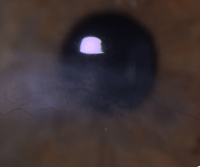 Q: Recently, I saw a patient with severe rosacea-related corneal opacity that is essentially 360° and, at certain areas, is approaching the visual axis. Some marginal thinning is evident, with a marked blepharoconjunctivitis and corneal findings that are apparently refractory (she has seen several doctors). She has tried oral doxycycline and topical steroids, but still has problems. Can you recommend any treatment options?
Q: Recently, I saw a patient with severe rosacea-related corneal opacity that is essentially 360° and, at certain areas, is approaching the visual axis. Some marginal thinning is evident, with a marked blepharoconjunctivitis and corneal findings that are apparently refractory (she has seen several doctors). She has tried oral doxycycline and topical steroids, but still has problems. Can you recommend any treatment options?
A: Rosacea is a chronic condition with periods of remission and exacerbations that requires long-term therapy to maintain control. “It is important when dealing with rosacea patients to remember that you can treat the symptoms effectively, but you cannot cure the patient,” says Lloyd Pate, O.D., a clinical associate professor at the University of Houston College of Optometry.
First, examine the patient’s medical records and ask her if any of the prior therapies were successful in controlling her condition while she was using them. Perhaps she only experienced a flare-up after cessation of the therapy.
“It’s not a uniform disease—everybody has a different tolerance to the actual insult, and everybody has a different response to the drugs,” says J. James Thimons, O.D., center director for Ophthalmic Consultants of Connecticut. Each patient will require an individualized treatment plan, which may integrate multiple treatments. Current treatment options include:
• Low-dose oral doxycycline. Oracea (Galderma) q.d. is available as a once-daily 40mg capsule, or you can use Periostat (CollaGenex) b.i.d. in a 20mg tablet, also available generically. “Keep the dosage below the therapeutic threshold because the therapy relies on doxycycline’s anti-inflammatory properties, not its antibiotic activity,” Dr. Pate says.
The drug typically is used in a pulsed fashion—with one month on treatment and one month off.

Severe rosacea-related corneal opacity; note the scar and vascularization along the bottom of the patient's eye. Photo: J. James Thimons, O.D.
• Azithromycin ointment. Many O.D.s also pulse-dose Azasite (Merck), with one month on and 30 to 45 days off. “The on and off pulsing doesn’t seem to create bacterial resistance,” Dr. Thimons says. “It also gets to the root of the problem—poor meibomium gland function.”
• Topical cyclosporine. A clinical trial of 37 patients with rosacea-associated eyelid and corneal changes found that those who used Restasis (Allergan) for three months showed an increase in Schirmer scores, improved mean tear film break-up time and a greater mean reduction in corneal staining scores.1 Another study showed topical cyclosporine is effective in treating ocular rosacea that is unresponsive to standard therapy.2 The majority of responsive patients (71%) were able to discontinue oral medications, but most required long-term maintenance with topical cyclosporine.2
• Topical metronidazole. Studies have suggested that metronidazole 1% gel or 0.75% cream q.d. or b.i.d. also is effective in treating rosacea blepharitis.3
• Tea tree oil. “In-office tea tree oil treatment followed by twice-daily lid scrubs with tea tree oil shampoo is a good therapy to consider,” Dr. Pate says.
• Intense pulsed light (IPL) therapy. IPL is a newer therapy that has been showing promise in ocular rosacea. Currently, Dr. Thimons is working on a clinical trial in which patients receive IPL treatments once a month for six months, with the goal of improving meibomium gland function. “So far the data looks really good,” he says. “I’d be happy if I had a treatment like this in addition to topical therapy.”
1. Schechter BA, Katz RS, Friedman LS. Efficacy of topical cyclosporine for the treatment of ocular rosacea. Adv Ther. 2009 Jun;26(6):651-9. Epub 2009 Jun 23.
2. Perry HD, Wittpenn JR, D’Aversa G, Donnenfeld ED. Topical cyclosporine 0.05% for the treatment of chronic, active ocular rosacea. Invest Ophthalmol Vis Sci. 2005;46: E-Abstract 2660.
3. Barnhorst DA Jr, Foster JA, Chern KC, Meisler DM. The efficacy of topical metronidazole in the treatment of ocular rosacea. Ophthalmology. 1996 Nov;103(11):1880-3.

